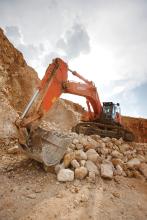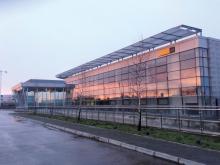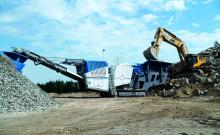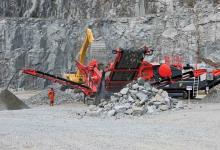A significant regional difference in business has marked the past year in the UK Aggregates Market, which has found itself in the doldrums generally, as ABE reports
Ten years ago, the UK produced 222 million tonnes of primary aggregates, and last year that figure was 33.3% down at 148 million tonnes. Interestingly, production of recycled materials stayed exactly the same at 60 million tonnes, which meant that the drop in total production was also exactly one-third from 2001 to 2011 (282 million tonnes down to 208 million tonnes).
The
MPA figures show that each year the industry supplies more than £5 billion (€6.1 billion) of materials to the £120 billion (€146 billion) construction sector and others.
Jerry McLaughlin is the association’s director of economics. He said: “The aggregates market has not really recovered yet from the recession. It went right down in 2008/09 and was totally flat in 2011/12.
“Last year there was quite a big regional variation: the markets in London and the south-east were strong, but everywhere else was lagging far behind. It is the biggest regional difference I can recall.”
He predicted that this year the market would go back down by 5-6% because of the government’s austerity package.
“That is only just beginning to affect the construction industry now because of the number of contracts already in the system,” he said. “This year, public sector construction will go down markedly, while the private sector will jog along. We do not see the market improving until later in 2013 because we have not seen the worst in public sector construction yet. But in 18 months’ time most of that will have happened, and big infrastructure schemes will start to generate work.”
There are about 300 businesses of varying sizes in the UK aggregates industry, ranging from very small to very large.
The top five movers,
Lafarge and
The speed of economic recovery is the biggest challenge facing the industry, said McLaughlin.
“It overpowers everything else. But there is also a range of regulatory issues that are of some concern. In England we have just had the announcement of planning guidelines, and they have generated a lot of political heat because of what the government is trying to do: in other words making the planning system more local.
“When the guidelines came out there was worry that some organisations would have free rein. But although planning policy is moving towards more local dimensions, they do recognise that minerals and aggregates need to be managed in a national, strategic way rather than locally. What happens at the sharp end is something that we will have to wait and see about.
“This has been a major issue for 18 months or so. Policy-wise it is OK, but we have to see how that policy translates into activity on the ground.”
Another area of constant struggle is the carbon issue, and McLaughlin believes that “the government here is determined to go beyond the European agreements.”
The government has to be careful that it does not increase the cost of energy to the extent that it becomes uncompetitive, he stressed.
“I think the government has understood that it needs to tread carefully, needs to manage the issue while keeping industry going. These measures are bearing down on the costs of aggregates businesses generally.
“There is concern that the aggregates businesses are having to deal with increasing energy costs at a time when the market is more difficult. It is a sensitive area at the moment.”
While the relatively small size of the UK means that transport of materials does not have as big an impact as it would in a much larger country, diverse geology and varying population densities do mean a certain amount of balancing out.
As described by the British Geological Survey, south-east of a line from Portland Bill (southern England) to Flamborough Head (north-east England), there are no significant areas of reasonably hard rock outcrop.
The south-east offers only sand and gravel which, although they can often make good concrete, are not generally as versatile as rock.
Perversely, this area actually has the highest demand for quality aggregate, not only because it is one of the most densely populated parts of Britain but also because it contains fast-growing areas around the Thames estuary, Ashford, Milton Keynes and Cambridge.
The largest areas of hard rock are the carboniferous limestone outcrops of Mendip and the nearby Bristol region. It is the darker, less pure of these that are best suited for use as aggregates, and aggregate extraction is concentrated at the eastern end of Mendip Hills, which is closest to the large markets of south-east England.
It is a feature that the quarries can also be readily hidden in the low ‘plateau’ topography, and avoid both the highly valued landscapes and water supply areas to the west. This is why two of the largest limestone quarries in Europe are located here.
Sustainability and biodiversity are key drivers in the UK market. Announcing that the association would continue to lobby for the reinstatement of the Aggregates Levy Sustainability Fund, MPA chief executive Nigel Jackson said: “Genuine sustainable development demands UK industries and supply chains are both resource efficient, where our industry is best in class in Europe, and also financially sustainable.
“Government needs to take great care to ensure that energy and carbon measures do not impose excessive costs on manufacturing industry, particularly energy-intensive industries such as cement and lime, which could drive the supply of essential and indigenously available resources overseas.”
Highlights of the UK’s record include the fact that aggregates businesses have planted a million trees over the past five years and recycled, and secondary materials accounted for 28% of the market in 2010.
Per capita production of aggregates in Great Britain 2010 was 3.3tonnes compared with a European average of 5.3tonnes, and per capita cement consumption in GB in 2010 was 158kg compared with the European average of 404kg.
More than 9% of aggregates sold were moved by rail, and the average road delivery distance for aggregates increased to 45.7km in 2010 with average loads increasing to 22.1tonnes. And the ratio of the area of aggregates sites restored to the area of land prepared for quarrying was 1:0.8.
To date, the MPA has identified the establishment of at least two National Nature Reserves; 22 local nature reserves; 15 field study and education centres and 13 nature trails.
MPA members manage or control an area of land of over 115 square miles (298km²), which is equivalent to a National Park such as the Norfolk Broads.
“It’s an area where we have a good story to tell in terms of our ability to get quarries to restore wildlife habitats,” said McLaughlin.
“There is appreciation of that within government. We have the potential to damage habitats, but also to benefit them, and this should be a net positive for the industry.”
Estimated shares in Great Britain aggregates and cement market, 2010
| Aggregates %) | Asphalt (%) | Ready-mixed concrete (%) | Cement* (%) | |
|---|---|---|---|---|
| Tarmac | 21 | 30 | 18 | 9 |
| Holcim | 18 | 25 | 12 | |
| Heidelberg | 14 | 14 | 17 | 20 |
| Cemex | 12 | 12 | 19 | 21 |
| Lafarge | 9 | 6 | 8 | 37 |
| Other | 27 | 14 | 26 | 13 |
| * cement, pulverised fuel ash and blast furnace slag Table: (source: Jefferies estimates, company data) NB: these shares refer to primary aggregates |










